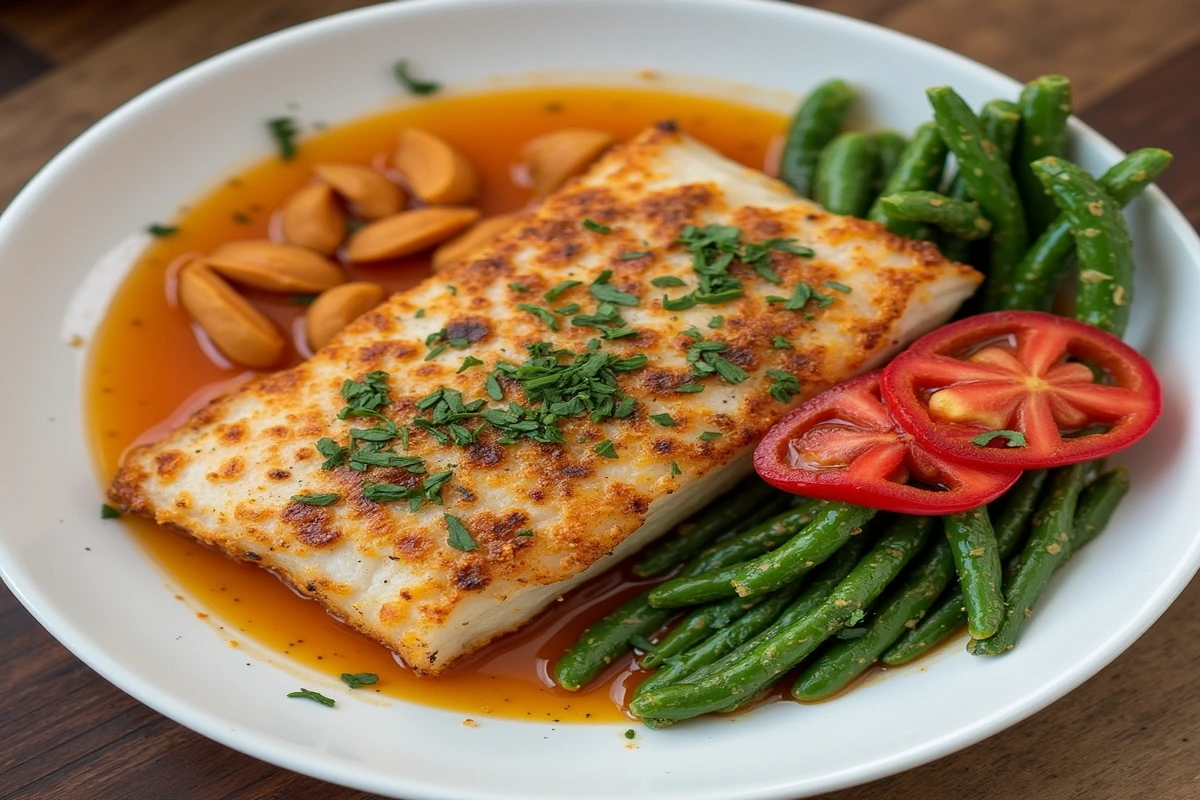Learn how to create your fish food recipe at home. Ensure your aquatic friends thrive with these nutritious options.
The Importance of a Quality Fish Food Recipe
A good fish food recipe is essential for the health and well-being of your fish. Commercial fish food is convenient. However, homemade options offer better control over ingredients. They also often are more nutritious for your aquatic pets.
Print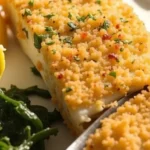
Easy Fish Food Recipe Guide
- Total Time: 2 hr
- Yield: About 1 cup 1x
Description
A homemade gel-based fish food suitable for goldfish, bettas, and tropical fish—packed with protein, veggies, and nutrients to support health, color, and growth.
Ingredients
1/2 cup peeled and chopped carrots
1/2 cup shelled peas
1/4 cup spinach or kale
1 clove garlic (optional, for immune boost)
1/4 cup unflavored gelatin
1/2 cup cooked shrimp, fish, or bloodworms (chopped)
1/4 cup fish flakes or pellets, crushed
1/2 cup water
Instructions
1. Steam or boil carrots, peas, and spinach until soft.
2. Add softened vegetables and garlic (if using) to a blender with cooked protein and fish flakes or pellets.
3. Blend into a thick puree, adding water as needed.
4. In a small saucepan, dissolve gelatin in 1/2 cup hot water and stir until fully dissolved.
5. Quickly stir the gelatin mixture into the blended fish food puree.
6. Pour into a shallow dish or silicone mold and refrigerate until fully set, about 1–2 hours.
7. Cut into small pieces or pop out of molds. Store refrigerated for up to 1 week or freeze for up to 1 month.
Notes
Feed small portions—only as much as your fish can eat in 2–3 minutes.
Customize with other fish-safe veggies like zucchini or sweet potato.
Avoid overfeeding to maintain tank water quality.
- Prep Time: 15 min
- Cook Time: 10 min
- Category: Pet Food
- Method: Boiled and Blended
- Cuisine: Aquatic
Nutrition
- Serving Size: Small cube or piece
- Calories: Varies
- Sugar: 0g
- Sodium: Low
- Fat: Low
- Saturated Fat: Low
- Unsaturated Fat: Low
- Trans Fat: 0g
- Carbohydrates: Low
- Fiber: Trace
- Protein: High
- Cholesterol: Low
Keywords: homemade fish food, gel food for fish, tropical fish diet, goldfish food, betta food
Why Homemade Fish Food?
Homemade fish food allows you to tailor the diet to your specific fish. You can choose high-quality ingredients. Moreover, you avoid potential additives. This approach leads to healthier and happier fish. Consequently, it’s a worthwhile endeavor.
Understanding Fish Nutritional Needs
Different fish species have different nutritional requirements. For example, some need more protein. Others need more plant matter. Therefore, a good fish food recipe must take these needs into account. Accordingly, it should be tailored to your fish.
Benefits of a Balanced Diet
A balanced diet from a quality fish food recipe promotes good health. It supports growth and vibrant colors. Furthermore, it strengthens the immune system. Thus, a well-balanced diet is crucial. This leads to healthier, more active fish.
Common Ingredients in a Fish Food Recipe
Several ingredients are commonly used in a fish food recipe. These components provide the necessary nutrients. They can range from protein sources to vegetables. Thus, a variety of ingredients is important.
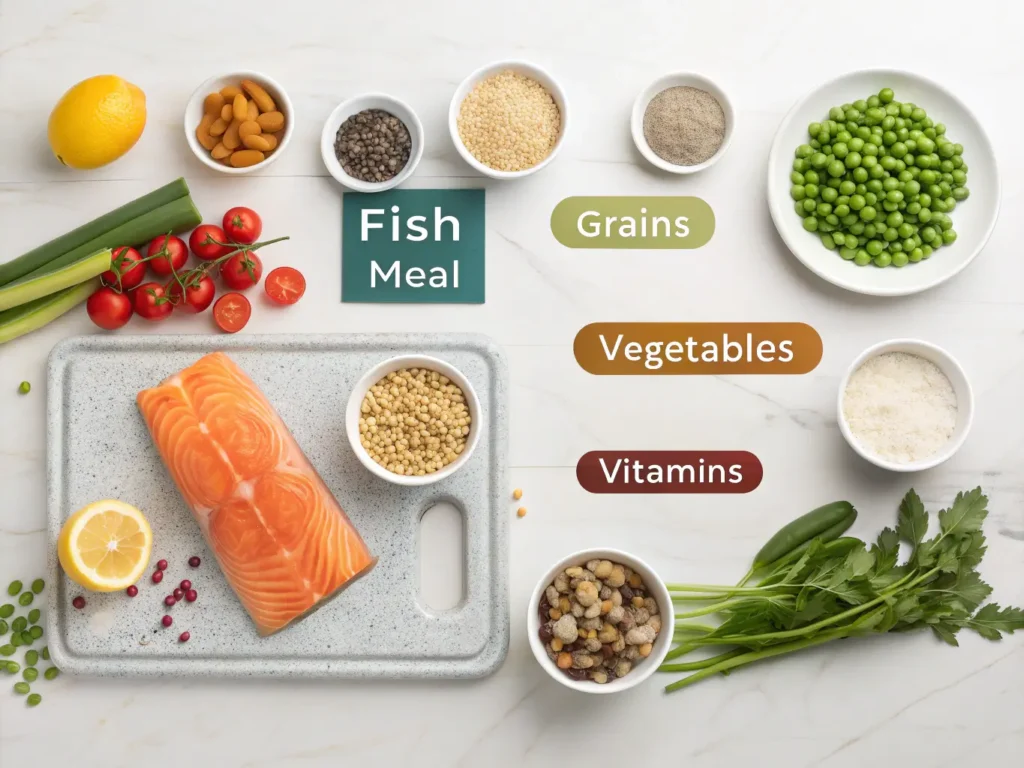
Protein Sources
Protein is vital for fish growth and development. Good protein sources include fish meal, shrimp, and spirulina. Also, you can use cooked eggs. Additionally, it may depend on the fish. For example, some may need more protein than others.
Plant Matter
Plant matter provides essential vitamins and fiber. Options include spinach, peas, and zucchini. Algae wafers are another good choice. Additionally, make sure to finely chop the veggies. This makes it easier for your fish to digest.
Binding Agents
Binding agents help to hold the fish food recipe together. Examples include gelatin and agar-agar. Furthermore, these make it easier for fish to eat. Therefore, it’s a very important component of the mix. They will keep everything together.
Vitamin and Mineral Supplements
Some fish food recipes may need additional vitamins and minerals. Fish require supplements, like calcium or vitamin D3. Moreover, it depends on the fish species. These can be found in pet stores. Therefore, it’s crucial to provide everything your fish needs.
Basic Fish Food Recipe Options
There are several basic fish food recipe options that you can make at home. These are simple and effective. They cater to different fish types. Thus, there is an option for many fish species.
Gelatin-Based Fish Food
A gelatin-based fish food recipe is easy to prepare. You mix cooked ingredients with gelatin. After that, you let it set. This creates a firm food that can be easily fed to your fish. Furthermore, it lasts for a while if stored in the fridge.
Dry Flake Fish Food
To make dry flake fish food, dehydrate your cooked ingredients. Grind them into a fine powder. This powder can be fed to your fish. The flakes should be stored in an airtight container to keep them fresh. Therefore, this method will keep longer than wet recipes.
Frozen Fish Food
Frozen fish food is a good way to store food for a long time. You can make batches and freeze them in small portions. Simply thaw before feeding. Consequently, this allows easy access to nutritious food.
Detailed Fish Food Recipe: Gelatin-Based
Here’s a detailed gelatin-based fish food recipe. It provides a well-balanced diet. It’s suitable for many fish species. Therefore, this is a good starting point for new fish keepers.
Ingredients Needed
You’ll need the following ingredients:
- 1/2 cup of cooked shrimp or fish
- 1/4 cup of cooked vegetables (such as spinach and peas)
- 1 tablespoon of spirulina powder
- 1 packet of unflavored gelatin
- 1/2 cup of water
Step-by-Step Instructions
First, finely chop the cooked shrimp or fish. Then chop the cooked vegetables. Next, mix all dry ingredients. After that, heat the water. Add the gelatin and mix until it dissolves. Mix in the dry ingredients. Finally, add the wet ingredients and let it set in the fridge. Therefore, each step must be followed carefully.
Tips for Best Results
Make sure to finely chop the ingredients. This helps with digestion. Also, make sure the gelatin is dissolved fully. Moreover, allow the mixture to set completely before feeding. Thus, following these tips ensures good results. Consequently, this recipe is easy.
Detailed Fish Food Recipe: Dry Flake
Now, let’s look at a dry flake fish food recipe. This is a good option for longer-term storage. Moreover, it’s convenient for everyday feeding. Therefore, this method is also easy and quick.
Ingredients Needed
You’ll need these ingredients:
- 1/2 cup of cooked fish meal
- 1/4 cup of dried algae flakes
- 1/4 cup of cooked carrots
- 1 tablespoon of shrimp meal
Step-by-Step Instructions
First, cook all ingredients. Then, dehydrate the cooked ingredients until they are completely dry. Next, grind all dehydrated ingredients into a fine powder. Finally, store in an airtight container. This process requires patience. Therefore, the ingredients must be completely dry.
Tips for Best Results
Dehydrate the ingredients completely. This prevents mold. Also, use a food processor or grinder. This will create a fine powder. Furthermore, store in an airtight container to keep the flakes fresh. Thus, these steps will ensure a good result.
Live Food for Fish: A Natural Approach
Live food is a great option for many fish. It provides a natural feeding experience. Furthermore, it can be very nutritious. Therefore, many fish thrive on live food.
Types of Live Food
Common live food options include brine shrimp, daphnia, and bloodworms. These are readily available at many pet stores. They can also be cultured at home. Consequently, there are many options.
Culturing Live Food at Home
You can culture your live food at home. Brine shrimp and daphnia are relatively easy to culture. This can be a cost-effective way to provide live food. Thus, it’s a great option for fish keepers.
Feeding Live Food Safely
Feed live food in moderation. Overfeeding can lead to water quality issues. Also, make sure to feed the proper types of live food. Furthermore, consider the size of the fish when feeding. Therefore, safety is very important.
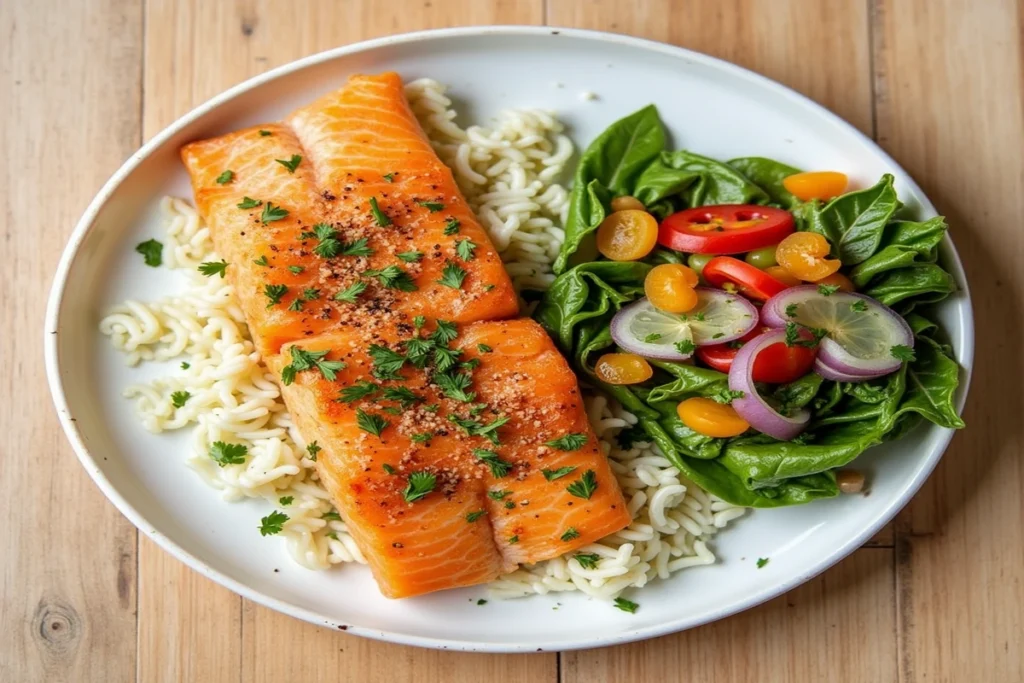
Tailoring Fish Food Recipes to Specific Fish
Tailoring fish food recipes is important for the different species of fish. Different fish have different nutritional needs. Therefore, it’s essential to customize their diet. Thus, this will promote better overall health.
Diet for Herbivorous Fish
Herbivorous fish primarily eat plants. Therefore, their fish food recipe should have lots of vegetables and algae. This will ensure they are getting their nutritional needs met. Thus, this diet should be tailored to plant-eating fish.
Diet for Carnivorous Fish
Carnivorous fish eat mainly meat. Their fish food recipe should be high in protein. Consider adding more fish meal, shrimp, or bloodworms. This gives them the necessary nutrients. Therefore, make sure to adjust the recipe.
Diet for Omnivorous Fish
Omnivorous fish eat both plants and meat. Their fish food recipe should have a balanced mix. This will ensure they have all their nutritional needs met. Therefore, you must consider both plant and protein sources.
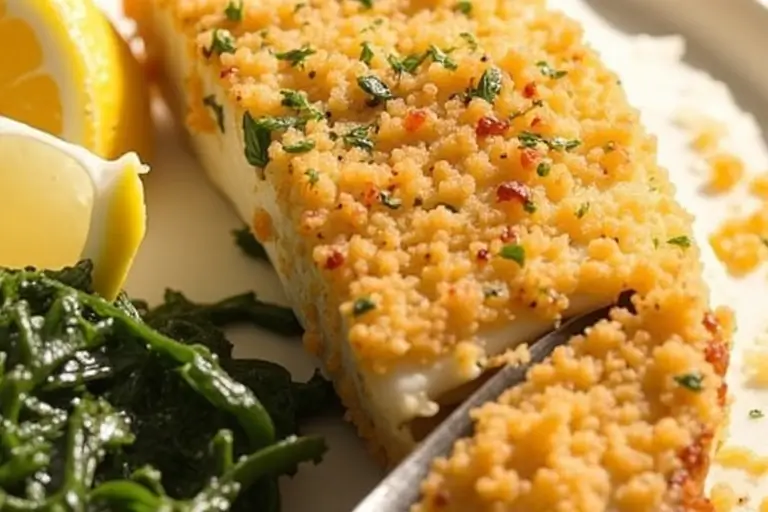
Don’t miss our banana wacky cake recipe, which also pairs beautifully with coconut pastry cream!
Storing Homemade Fish Food
Proper storage of homemade fish food is essential. This will keep it fresh. Also, it will prevent spoilage. Thus, using the correct methods is a must.
Refrigerator Storage
Gelatin-based fish food can be stored in the refrigerator for a few days. Store it in an airtight container. This prevents it from drying out. Therefore, it will stay fresh for a few days.
Freezer Storage
Frozen fish food can be stored in the freezer for several months. Freeze in small portions for easy feeding. Therefore, it can last a long time when stored properly. Consequently, freezing is a great option.
Dry Storage
Dry flake fish food should be stored in an airtight container. This helps to maintain freshness and prevent moisture from ruining the mixture. Therefore, a dry place is important. The storage container must also be airtight.
Common Mistakes When Making Fish Food
There are some common mistakes to avoid when making fish food. Understanding these will ensure better results. Avoiding these mistakes is important for the health of your fish.
Overfeeding
Overfeeding can lead to water quality problems. Only feed your fish as much as they can consume in a few minutes. This will prevent uneaten food from polluting the water. Therefore, be mindful when feeding your fish.
Using Poor Quality Ingredients
Avoid using low-quality ingredients. This can harm your fish. Always use fresh and nutritious ingredients. Therefore, make sure to buy from a reputable supplier. Do not use old or suspect ingredients.
Incorrect Storage
Incorrect storage can lead to spoilage. Always store homemade fish food properly. This prevents mold growth. It will also keep your food fresh. Therefore, follow the storage directions.
Frequently Asked Questions About Fish Food Recipes
What is the best homemade food for fish?
The best homemade fish food depends on the fish. However, a balanced diet with protein, plants, and vitamins is key. Thus, it should cater to the specific species of fish you own. This will meet their specific needs.
How to make homemade fish feed?
To make homemade fish feed, combine cooked protein, vegetables, and a binding agent. Then mix well. You can then either refrigerate, freeze, or dehydrate your food. This will ensure proper storage methods. Thus, there are many options to consider.
What are the best ingredients for fish food?
The best ingredients for fish food include cooked fish or shrimp for protein. Algae and leafy greens are great options. Additionally, choose vitamin and mineral supplements. Therefore, make sure to use the highest-quality options available.
How to make live food for fish?
You can culture live food for fish using brine shrimp eggs or daphnia cultures. Follow specific instructions for each type of live food. These are also widely available at most pet stores. It’s a great way to provide live food for your fish.
Conclusion
Creating your fish food recipe is a rewarding experience. It allows you to provide the best possible nutrition for your fish. Furthermore, it offers more control over the ingredients. This detailed guide provides everything you need to get started. You will also have the best results if you pay close attention to the details.

